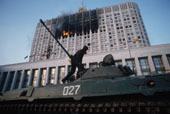The Black Day of Russia's White House
It is dangerous in Russia to take armed people out in the streets to fight the regime
Twelve years ago, Russia went through a civil war, a smaller one than the civil war occurred at the beginning of the 20th century, but still it was an epoch-making event for the country. The civil war of 1993 was really violent and cruel; the actual number of killed and wounded has never been estimated precisely.

The overturn was provoked by a split in the political authority. September 19, 1993, Russia President Boris Yeltsin signed a decree to dismiss the parliament and abolish the Constitution. Chairman of the Supreme Council Ruslan Khasbulatov and Vice-president Alexander Rutskoi strongly opposed to the decree and decided to deprive Yeltsin of the authority. For this purpose they appealed to the Constitutional Court, but the society did not care about the legal procedure. The House of the Government was blockaded; it was cut off the water and electricity supply. That was a rather nervous struggle. Finally, a group of armed men seized the Moscow city administration building. Somehow they got a grenade cup discharge, the weapon with which the people decided to storm the Ostankino television center. It is perfectly clear now that the people were provoked to do so: about fifty lorries with no drivers inside were left near the House of the Government. The desperate people sitting in the White House gave way to the provocation.
Early in the morning October 4, 1993 the White House was encircled. What happened next some people still call "execution of the parliament". It was much talked right after the event, and the talks still continue today, that there was some armed resistance, that "defenders" of the House of the Government allegedly seized too much weapons. There probably were weapons but many witnesses of the events did not see them at all. There was General Makashov (he is now representing the Communist Party in the Parliament) with a Kalashnikov gun and three cartridge belts, but the general never shot.
On the day when the House of the Government was stormed, about one hundred of strange men wearing Cossack caps settled in the windows of the building with double-barreled guns or hunting rifles. The men incurred the inimical fire and spoiled the whole of the interior. At that those who fired the House of the Government did not look better than the "defenders". Among them there were strong athletic men who jumped out of armored troop-carriers with better weapons and fired the building. Nobody knew where the people came from. It was suggested that they were probably engaged by Boris Berezovsky, Vladimir Gusinsky, young Mikhail Khodorkovsky and other bankers who afterwards financed the Yeltsin Family. It is astonishing that 12 years after the events, Mikhail Khodorkovsky himself arrived at the parliamentary republic ideas that pushed Khasbulatov and Co.
The storm of the White House was in fact the mixture of senseless outrage and obvious sloppiness. Majority of people sitting in the building - clerks, cleaners, barkeeprs - were rather peaceful and did not want to fight the regime. But none of them was allowed to leave the building. Instead, firing of the building began without warning.
Then, tanks reached the building and began to fire the top storeys where no people stayed at that moment. Was it done to scare the people inside of the building? But normal people were seriously scared by the very fact of the storm. There were just about 200 of fanatic defenders of the White House. It would take the Alfa special forces ten minutes to neutralize the people. But the storm lasted for at least ten hours, and the firing never stopped during the time. It did not stop even when truce envoys came to the White House and offered to let men, elderly and other non-combatants out of the building.
On the night before the storm, I talked to three students who came to the White House to stand up for the Constitution. They had no weapons at all. To tell the truth, there were just few of such ideological people who sincerely wanted to stand up for the Constitution among those who stayed near the House of the Government.
The civil war of 1993 taught us the most important lesson that it is dangerous in Russia to take armed people out in the streets to fight the regime.
Nikolay Troitsky
Subscribe to Pravda.Ru Telegram channel, Facebook, RSS!


